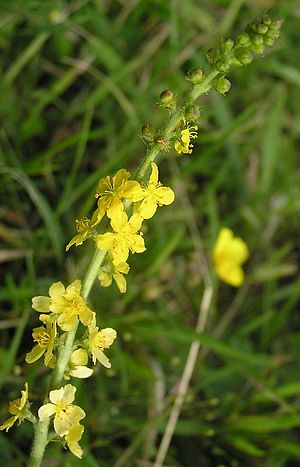Note: This is a project under development. The articles on this wiki are just being initiated and broadly incomplete. You can Help creating new pages.
Agrimonia eupatoria - Agrimony
Agrimony is a species of agrimony that is often referred to as Agrimonia eupatoria, church steeples or sticklewort. The whole plant is dark green with numerous soft hairs. The soft hairs aid in the plant's seed pods sticking to any animal or person coming in contact with the plant. The flower spikes have a spicy odor like apricots. In the Language of Flowers Agrimony means thankfulness or gratitude.
Uses
Wounds, Cuts, snakebites, Curing liver disorders, Skin eruptions, Blotches, Pimples, Diarrhea, Sore throats.
Parts Used
Chemical Composition
Contains volatile oils, flavonoids, apigenin, luteolin, quercetin, kaempferol, tiliroside, triterpene glycosides including euscapic acid and tormentic acid, phenolic acids, and 3%–21% tannins.[1]
Common names
| Language | Common name |
|---|---|
| Kannada | Hebbalasu, Kadu halasu |
| Hindi | Kathal |
| Malayalam | Ayani, Anjili, Ayini plavu |
| Tamil | Kattuppala, Aiyini pala, Kurangu pala, Pei pala |
| Telugu | Adavi panasa |
| Marathi | NA |
| Gujarathi | NA |
| Punjabi | NA |
| Kashmiri | NA |
| Sanskrit | Lakucha, Lakucah, Panasah |
| English | Wild Jack |
Habit
Identification
Leaf
| Kind | Shape | Feature |
|---|---|---|
| Simple | lanceolate | alternate, spiral, clustered at twigs end, tawny hirsute, caducous, leaving annular scar |
.[2]
Flower
| Type | Size | Color and composition | Stamen | More information |
|---|---|---|---|---|
| Unisexual | 14cm long | Pendulous, Ovoid | male flowers in axillary spikes, pendulous; female flowers in axillary spikes, ovoid |
Fruit
| Type | Size | Mass | Appearance | Seeds | More information |
|---|---|---|---|---|---|
| Syncarp (sorosis), subglobose or ellipsoid with long echinate processes, orange when ripe | seeds many, ovoid. | {{{6}}} |
Other features
List of Ayurvedic medicine in which the herb is used
- Vishatinduka Taila as root juice extract
Where to get the saplings
Mode of Propagation
How to plant/cultivate
In terms of taking care of the plant, minimal pruning is required Cutting off dead branches from the interior of the tree is only sometimes needed. In addition, twigs bearing fruit must be twisted or cut down to the trunk to induce growth for the next season. Branches should be pruned every three to four years to maintain its productivity. Stingless bees such as Tetragonula iridipennis are jackfruit pollinators, and as such, play an important role in jackfruit cultivation.
Commonly seen growing in areas
Photo Gallery
References
External Links
- Artocarpus hirsutus on ENVIS Centre on Conservation of Medicinal Plants
- Artocarpus hirsutus on India Biodiversity Portal
- Artocarpus: A review of its traditional uses, phytochemistry and pharmacology
- Artocarpus: A review of its phytochemistry and pharmacology
- Pharmacognostical studies on the bark of Artocarpus hirsutus Lam
- Ayurvedic Herbs known to be helpful to treat Wounds
- Ayurvedic Herbs known to be helpful to treat Cuts
- Ayurvedic Herbs known to be helpful to treat snakebites
- Ayurvedic Herbs known to be helpful to treat Curing liver disorders
- Ayurvedic Herbs known to be helpful to treat Skin eruptions
- Ayurvedic Herbs known to be helpful to treat Blotches
- Ayurvedic Herbs known to be helpful to treat Pimples
- Ayurvedic Herbs known to be helpful to treat Diarrhea
- Ayurvedic Herbs known to be helpful to treat Sore throats
- Herbs with Dried Folaige used in medicine
- Herbs with whole herb used in medicine
- Herbs with common name in Kannada
- Herbs with common name in Hindi
- Herbs with common name in Malayalam
- Herbs with common name in Tamil
- Herbs with common name in Telugu
- Herbs with common name in Sanskrit
- Herbs with common name in English
- Habit - Herb
- Index of Plants which can be propagated by Seeds
- Index of Plants which can be propagated by Cuttings
- Index of Plants which can be propagated by Airlayers
- Herbs that are commonly seen in the region of Western Ghats
- Herbs that are commonly seen in the region of Malabar Coast
- Herbs


